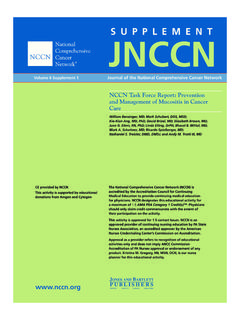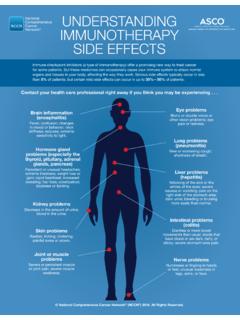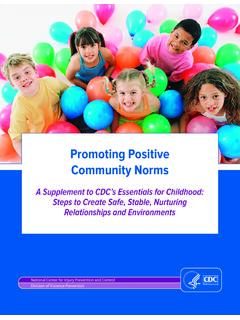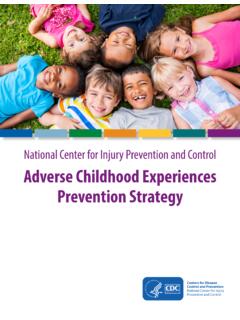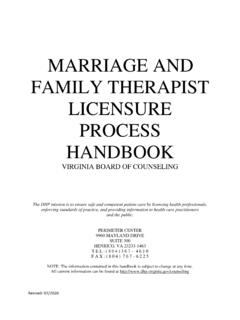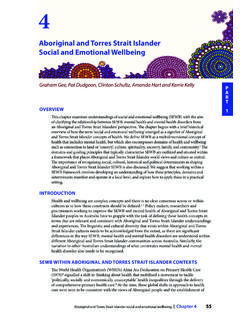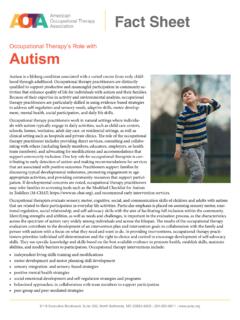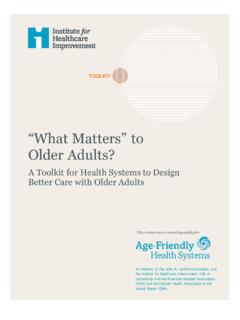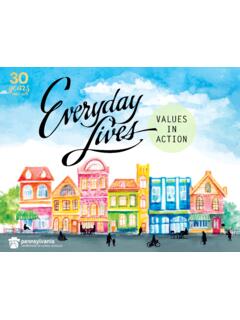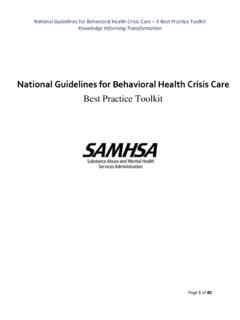Transcription of NCCN Guidelines for Patients: Acute Myeloid Leukemia
1 Available online at PATIENTS 20212022 Presented with support from: Acute Myeloid Leukemia 1 NCCN Guidelines for Patients Acute Myeloid Leukemia , 2022 Acute Myeloid LeukemiaIt's easy to get lost in the cancer world 9 Step-by-step guides to the cancer care options likely to have the best results 9 Based on treatment Guidelines used by health care providers worldwide 9 Designed to help you discuss cancer treatment with your doctorsLet NCCN Guidelines for Patients be your guide 2 NCCN Guidelines for Patients Acute Myeloid Leukemia .
2 2022 Acute Myeloid Leukemia 2021 National Comprehensive Cancer Network, Inc. All rights reserved. NCCN Guidelines for Patients and illustrations herein may not be reproduced in any form for any purpose without the express written permission of NCCN. No one, including doctors or patients, may use the NCCN Guidelines for Patients for any commercial purpose and may not claim, represent, or imply that the NCCN Guidelines for Patients that have been modified in any manner are derived from, based on, related to, or arise out of the NCCN Guidelines for Patients.
3 The NCCN Guidelines are a work in progress that may be redefined as often as new significant data become available. NCCN makes no warranties of any kind whatsoever regarding its content, use, or application and disclaims any responsibility for its application or use in any Foundation seeks to support the millions of patients and their families affected by a cancer diagnosis by funding and distributing NCCN Guidelines for Patients. NCCN Foundation is also committed to advancing cancer treatment by funding the nation s promising doctors at the center of innovation in cancer research.
4 For more details and the full library of patient and caregiver resources, visit National Comprehensive Cancer Network (NCCN) / NCCN Foundation 3025 Chemical Road, Suite 100 Plymouth Meeting, PA 19462 Guidelines for Patients are developed by the National Comprehensive Cancer Network (NCCN )National Comprehensive Cancer Network NCCN 9 An alliance of leading cancer centers across the United States devoted to patient care, research, and educationCancer centers that are part of NCCN: Guidelines for Patients9 Present information from the NCCN Guidelines in an easy-to-learn format9 For people with cancer and those who support them 9 Explain the cancer care options likely to have the best resultsFree online at Clinical Practice Guidelines in Oncology (NCCN Guidelines )
5 9 Developed by doctors from NCCN cancer centers using the latest research and years of experience9 For providers of cancer care all over the world 9 Expert recommendations for cancer screening, diagnosis, and treatmentFree online at These NCCN Guidelines for Patients are based on the NCCN Guidelines for Acute Myeloid Leukemia , Version December 2, Guidelines for Patients Acute Myeloid Leukemia , 2022 Acute Myeloid LeukemiaNCCN Guidelines for Patients are supported by funding from the NCCN Foundation To make a gift or learn more, please visit or e-mail Guidelines for Patients Acute Myeloid Leukemia , 20225 NCCN Guidelines for Patients Acute Myeloid Leukemia .
6 2022 Acute Myeloid LeukemiaContents6 AML basics11 Testing and diagnosis25 Treating AML39 AML60 APL70 BPDCN78 Making treatment decisions91 Words to know94 NCCN Contributors95 NCCN Cancer Centers96 Index6 NCCN Guidelines for Patients Acute Myeloid Leukemia , 202261 AML basics7 Blood9 Acute Myeloid leukemia10 Key points7 NCCN Guidelines for Patients Acute Myeloid Leukemia , 20221 AML basics BloodAcute Myeloid Leukemia (AML) is a fast-growing blood cancer that starts in the blood stem cells of bone marrow.
7 There are many types of AML found in adults. This chapter will provide an overview of Myeloid Leukemia (AML) is a type of blood cancer. Blood is a tissue. A tissue is a group of cells that work together to perform a function. Blood s function is to move oxygen and nutrients throughout your body and carry away waste. Blood also plays an important role for the immune system and in preventing cells Your blood contains different types of are 3 types of blood cells: Red blood cells (erythrocytes) White blood cells (leukocytes), which include granulocytes, monocytes, and lymphocytes Platelets (thrombocytes) Blood cells are being replaced in your body all the time.
8 Many have a short lifespan . Some white blood cells live less than one day. Your body makes one million red blood cells every second! Blood stem cellsBone marrow contains stem cells. A blood stem cell is an immature cell that can develop into a red blood cell, white blood cell, or Guidelines for Patients Acute Myeloid Leukemia , 20221 AML basics BloodHow blood cells are formedBone marrow is the sponge-like tissue in the center of most bones. Inside your bone marrow are early blood-forming cells called blood stem cells (hematopoietic stem cells).
9 All types of blood cells start as blood stem cells. At any given time, bone marrow will have cells in various stages of development, from very immature to almost fully mature. With each stage, the blood stem cell changes and gets closer to what it is meant to be. After a blood stem cell develops into a red blood cell, white blood cell, or platelet, it is released in your bloodstream as needed. Blood stem cells can copy themselves or self-renew. These cells are rare. Blood stem cells can also make new cells that are committed to becoming a certain type of blood cell.
10 These are called progenitor cells or precursor cells. Progenitor cells are much more common than blood stem cells. Progenitor cells can become red blood cells, white blood cells, or are different types of progenitor cells: Lymphoid progenitor cells form into lymphoblasts that mature into lymphocytes. Myeloid progenitor cells from into myeloblasts and other non-lymphoid blood cell formationAll blood cells start as blood stem cells. A blood stem cell has to mature or go through many stages to become a red blood cell, white blood cell, or platelet.



